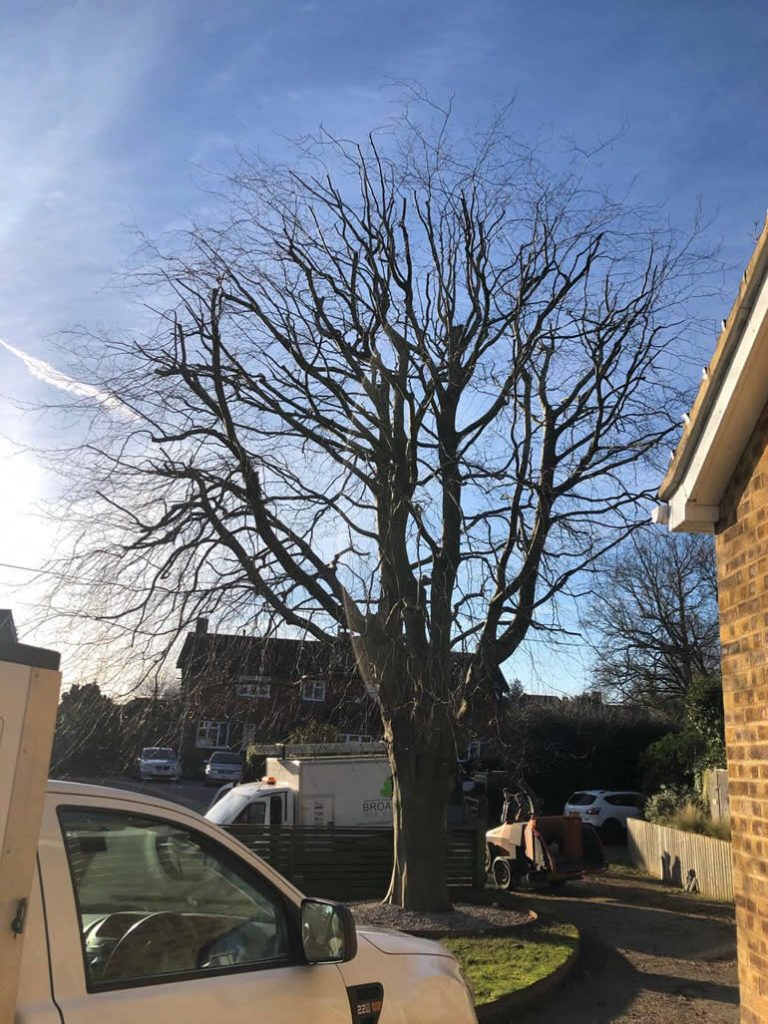If you have a tree with many dead or overlapping branches and the canopy looks unbalanced, tree crown thinning might be the perfect solution. However, it’s important to understand exactly what crown thinning is, if it’s the right fit for your tree and if it will help you achieve the look you want. So, what is crown thinning on a tree?
Crown thinning is the process of removing selected branches, without altering the shape or size of the tree. It includes the removal of all dead or weak branches, those growing into the canopy, and any crisscrossing branches. The result should be an evenly balanced crown.
Read on for a more in-depth explanation of what tree crown thinning is and the main advantages of this tree service.
What is Crown Thinning?
Professional crown thinning focuses on removing select branches within the crown to thin it out. It should not reduce the tree’s shape, size or height. The removed branches are usually dead, weak, duplicated or overreaching. This helps to improve the look of the tree by creating a more evenly balanced crown.
What Are The Advantages of Crown Thinning?
There are many advantages of crown thinning, both for the tree, for the property and for the people living there. Here are some of the main benefits:
- More light can pass through the branches, brightening your garden or home. If your tree is preventing light from reaching your garden or entering your window, a crown thinning allows more light to pass through. This is also beneficial for the tree as sunlight can reach the crown’s interior and fewer branches are trying to compete for nutrients and light.
- Less chance of the tree being knocked down in a storm. When a tree has too many branches, strong winds cannot move through the canopy increasing the chance that the entire tree is blown over. This can cause enormous damage to your garden or even your home. Crown thinning significantly reduces the likelihood of this damage. Read more on why trees fall over in a storm with our dedicated blog.
- Removing dead or damaged branches reduces the risk of damage from falling branches. This is especially important if your tree overhangs your property or is in a high-footfall area.
- Encourages the tree to produce more fruits and flowers. Crown thinning results in higher flower and fruit production. This is because there is more sunlight and fewer branches are competing for resources.
- Improves the look of the tree by creating a more balanced crown. Tree thinning professionals will ensure a balanced and attractive branch structure that can enhance the aesthetic appeal of your tree.
When Should Crown Thinning Be Carried Out?
Most types of pruning are usually best undertaken during the winter months. However, when it comes to crown thinning it’s best to approach a professional tree surgeon for guidance, as the ideal time of year can vary from tree to tree.
We’ve also put together this guide on the best time of year to do tree surgery with a breakdown of the best time for pruning different tree species.
What is the Difference Between Crown Thinning and Crown Reduction?
Crown thinning and crown reduction are similar processes, but crown reduction is the more extreme option. While crown thinning will preserve the size and height of your tree, crown reduction will result in a smaller overall volume and tree size. However, the overall shape of your tree will still be preserved.
If your tree’s height is blocking sunlight or you’re uncomfortable with its height, perhaps because it’s close to your property, a complete crown reduction might be the preferable solution. At Broadleaf Tree Surgery, we offer a professional full crown reduction service that’s designed to improve the health, safety and appearance of your tree.
Professional Tree Crown Thinning by Broadleaf Tree Surgery
If you’re looking for a professional and experienced team to perform tree crown thinning, Broadleaf Tree Surgery can help. Our team is highly qualified and has years of experience in the field of tree care.
We always try to keep as much of the tree as possible while still achieving the look you want, helping to avoid long-term damage to your tree. Our team uses professional equipment to ensure you and your property’s safety while we carry out the crown thinning. Once the job is complete and you’re happy with your tree’s new look, we remove all the waste, which is then chipped and recycled as fertiliser on a local farm.
If you’re after professional crown thinning in the Kent, Maidstone, Medway or surrounding areas, please get in touch with our team for a free site visit and no-obligation quote. Or view our full range of tree services on our website.
Crown Thinning FAQs
What is a Crown in a Tree?
The crown refers to the top part of the tree, which includes its branches and leaves. It’s sometimes referred to as a canopy instead. The crown is one of the most important parts of a tree. It produces food using water absorbed from the roots and carbon taken from the carbon dioxide in the air.
What Type of Tree Can Be Thinned?
Crown thinning is most effective on broad-leaf, hardwood trees, such as oak, birch, cherry or sycamore. However, if you’re unsure if crown thinning is suitable for your tree, it’s always best to ask a tree specialist for guidance.
What is The Difference Between Crown Thinning, Crown Reduction and Tree Topping?
Tree topping is an aggressive pruning method and involves cutting off most of the tree’s crown. Most professionals don’t recommend or offer this technique as it can cause severe and long-lasting damage to trees.
If you’d like to reduce the height of your tree, a complete crown reduction will remove the bulk of your tree without affecting the shape. This is a much less harmful method of pruning than tree topping. If you’d like your tree’s canopy thinned out but want to keep its height, size and shape, crown thinning is the best option.
For a complete breakdown of the different ways to reduce your tree’s height, have a look at our blog, ‘How To Safely Reduce The Size Of A Tree’.



